The LSI MegaRAID 9361-8i SAS3 RAID controller is a 12Gb/s storage adapter featuring PCIe 3.0 host interface, 1GB DDRIII cache memory, 1.2GHz PowerPC 476 dual core 12Gb/s ROC, and 8 12Gb/s SATA+SAS ports. With twice the maximum data transfer rate of 6Gb/s SAS solutions, the 9361-8i delivers enough bandwidth to fully saturate the PCI Express Gen3 bus. Along with superior data transfer rates, the 9361-8i offers enterprise-class data protection and security and supports CacheVault flash cache protection. LSI first-to-market 12Gb/s SAS solutions, such as the 9361-8i, are geared for the performance and security demands of next generation of enterprise data storage.
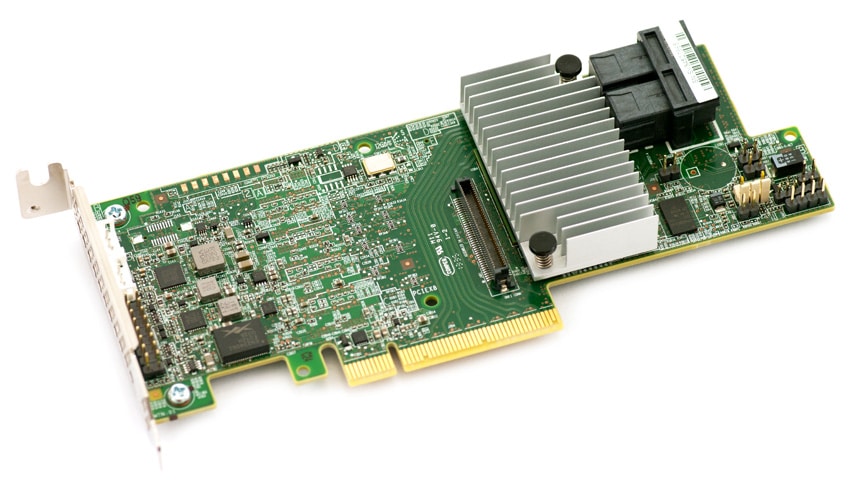
LSI and Adaptec are fiercely competing with one another in the emerging SAS3 space, each pushing the bar higher with every release. With the 9361-8i, LSI is delivering a SAS RAID controller that has a high data transfer rate of 12Gb/s, along with backward compatibility for 6Gb/s and 3Gb/s (allow for up to 128 3Gb/s, 6Gb/s, or 12Gb/s SATA and SAS devices), supports RAID levels 0,1,5,6,10, 50, and 60, and enterprise data protection though CacheVault which allows a drive to be placed in shield state if there is a physical drive failure, to determine if the drive actually failed and can be restored.
The 9361-81 is part of the larger LSI 12Gb/s SAS RAID card family. The 9361 also comes in a four port internal configuration, 9361-4i. LSI also offers the 9341-4i and 9341-8i which are 4 and 8 port internal cards that support fewer drives and do not have onboard cache. The LSI MegaRAID 9361-8i SAS RAID is shipping now, comes with a 3-year warranty and has a street price at $570.00.
LSI MegaRAID 9361-8i SAS RAID Specifications:
- Order Part Number: LSI00416
- RAID Levels: 0,1,5,6,10, 50, and 60
- Form Factor:
- Low Profile
- 2.535”H x 6.6”L (64mm x 167mm)
- Ports: 8 Internal
- Connectors: 2 x mini-SAS SFF8643 internal connectors (horizontal mount)
- Bus Interface: x8 lane PCI Express 3.0 compliant
- Processor: LSISAS3108 dual core RAID on Chip (ROC)
- Cache: 1GB 1866MHz DDRIII SDRAM
- Cache Protection: Optional CacheVault Flash Module (LSICVM02)
- Operating Temperature: Maximum ambient: Controller Card: 55°C, with optional CacheVault accessory (LSICVM02): 55°C
- Operating Voltage: +3.3V, +12V
- Regulatory Certifications: EN55022, EN55024, EN60950, EN 61000-3-2, EN 61000-3-3; FCC Class A, Class B; UL1950; UL; CSA C22.2; VCCI; RRL for MIC; BSMI; C-tick
- OS Support: Microsoft Windows Server 2012/8 & 7/2008/Vista/2003/XP, Linux, SolarisTM (x86), Netware, FreeBSD, and VMware
- Warranty: 3 years
Design And Build
At the heart of the LSI MegaRAID 9361-8i lays the LSISAS3108 dual core RoC controller, coupled with 1GB of 1866MHz DDRIII SDRAM, which offers data protection and performance. When a physical drive failure occurs, it goes into “shield state”. Once this happens, the MegaRAID controller immediately begins drive diagnostics in order to discover if the drive has actually failed and/or if it can be restored; this is a very handy feature for users looking to save time and money.
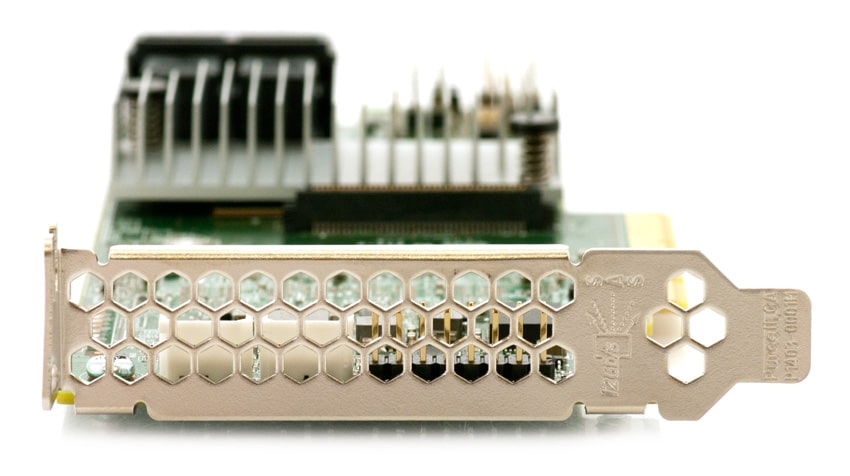
The 9361-8i can connect up to 128 SATA or SAS drives with its eight internal 12Gb/s SATA and SAS ports and can fit into rack-mounted servers with low-profile HHHL form factor and side-mounted SAS connectors.
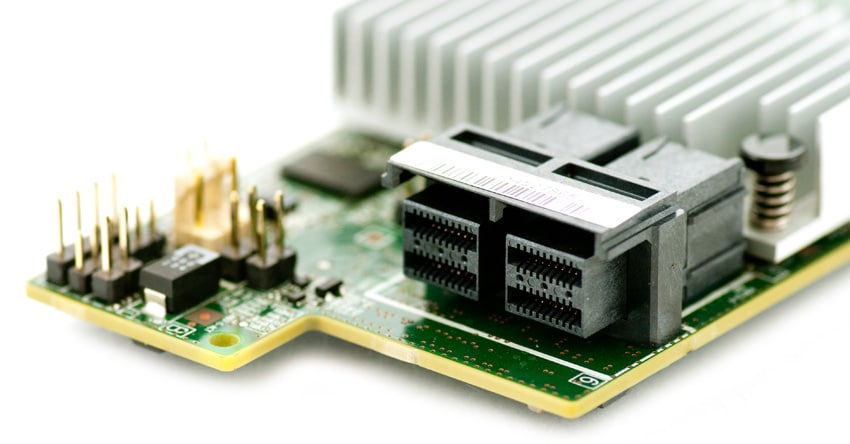
The two SFF-8643 mini-SAS HD-4i internal connectors connects the controller by cable to SAS drives or SATA drives. The 9361-series does not support external connectors, so for JBOD solutions you would need to step back to SAS2 cards such as the LSI 9286-8e for now.
SuperStorage Server 2027R-AR24NV Test Server Specifications:
- 2 x Intel Xeon E5-2687 v2 (3.4GHz, 25MB Cache, 8-cores)
- Intel C602 Chipset
- Memory – 256GB (16 x 16GB) 1333Mhz Micron DDR3 Registered RDIMMs
- Windows Server 2012 Standard – 100GB Micron RealSSD P400e Boot SSD
- Supermicro SAS3 HBA (LSI SAS 3008 Controller)
- LSI MegaRAID 9361-8i
- 8 x 400GB HGST Ultrastar SSD800MM
Enterprise Synthetic Workload Analysis
Our enterprise benchmark process preconditions each storage array into steady-state with the same workload the device will be tested with under a heavy load of 16 threads with an outstanding queue of 16 per thread, and then tested in set intervals in multiple thread/queue depth profiles to show performance under light and heavy usage.
Preconditioning and Primary Steady-State Tests:
Throughput (Read+Write IOPS Aggregate)
Average Latency (Read+Write Latency Averaged Together)
Max Latency (Peak Read or Write Latency)
Latency Standard Deviation (Read+Write Standard Deviation Averaged Together)
Our Enterprise Synthetic Workload Analysis includes profiles based on real-world tasks. These profiles have been developed to make it easier to compare to our past benchmarks as well as widely-published values such as 8k 70/30 which is commonly used for enterprise products.
- 4k
- 100% Read or 100% Write
- 100% 4k
- 8k 70/30
- 70% Read, 30% Write
- 100% 8k
- 8k (Sequential)
- 100% Read or 100% Write
- 100% 8k
- 128k (Sequential)
- 100% Read or 100% Write
- 100% 128k
To measure the peak performance of the LSI MegaRAID 9361-8i, we leverage eight HGST Ultrastar SSD800MMs inside our Supermicro SuperStorage Server 2027R-AR24NV. These were then configured in different RAID or nested RAID types to show how performance scaled across supported modes.
In this 4k throughput test, LSI MegaRAID in RAID0 configuration topped the chart in read and write speed, boasting an impressive 556,427 IOPs read and 573,489 IOPs write. Nothing else came even remotely close in the Write speed column; however the MegaRAID RAID 60 narrowly beat out its read throughput with 556,870 IOPS.
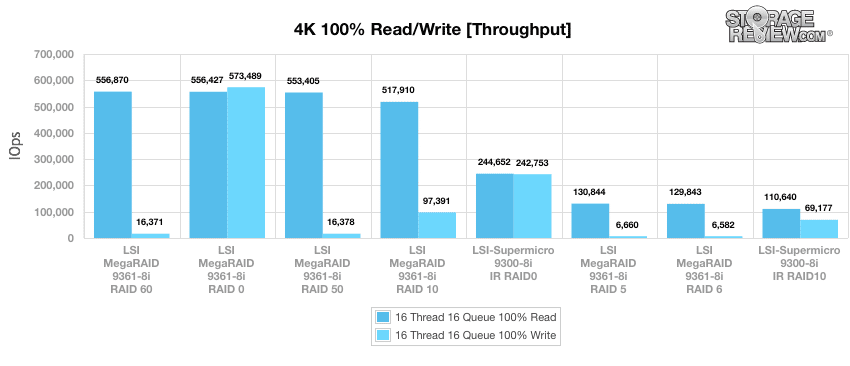
As was the case in our 8K tests, LSI’s MegaRAID RAID 5 and 6 configurations had significantly higher average latency, especially in the Write column, which reached 38.43ms and 38.89ms respectively. Every other configuration was performed generally well.
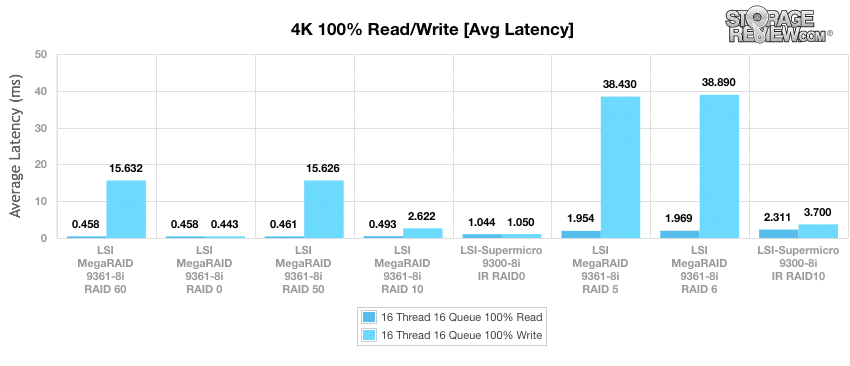
When comparing peak latency, everyone performed well with the exception of the huge blip in the graph that is the 9300-8i IR in RAID 10 configuration.
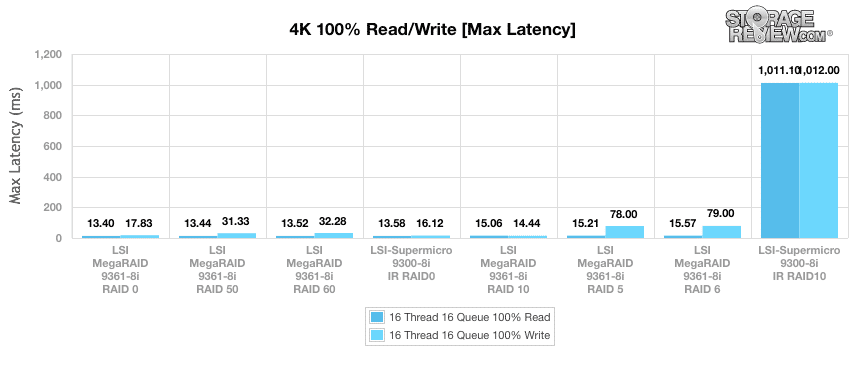
Looking further into the overall latency, the LSI 9300-8i IR in RAID10 still shows weakness in regards to handling parity data when compared to the other H/W raid from 9361-8i.
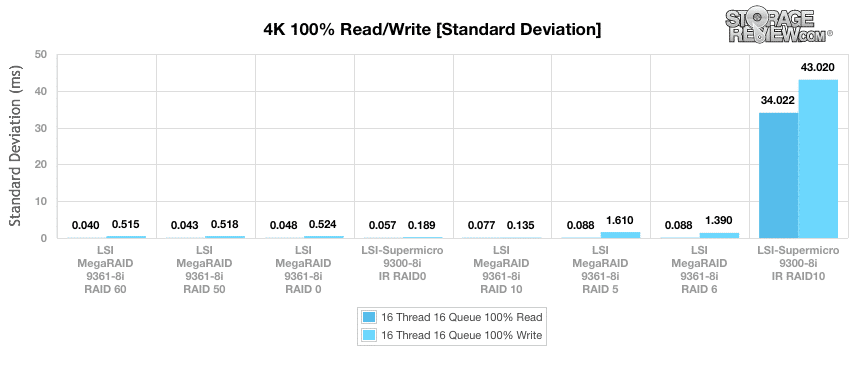
In our 8k mixed workload test, 70% Read, 30% Write, measuring throughput, the LSI MegaRAID RAID0 configuration unsurprisingly offered the best overall performance at virtually every depth peaking over 450,000 IOPS, which was almost double the throughput of the second place RAID 10 configuration. The surprising difference in this review was how much of a performance boost the RAID card offered over the LSI 9300-8i IR in RAID0, which topped out at roughly half the throughput. The same difference can be seen comparing RAID10 on the 9361-8i vs the 9300-8i IR.
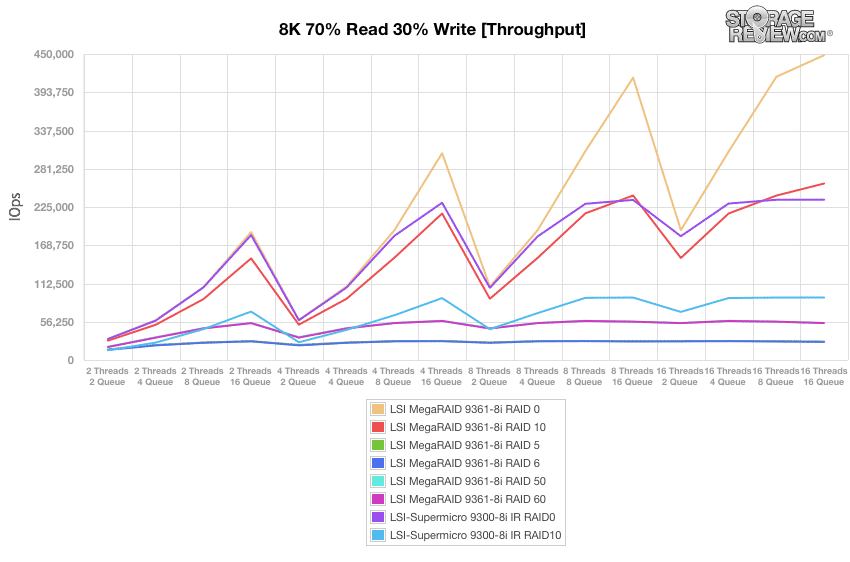
The LSI-Supermicro 9300-8i in RAID 0 configuration offered the lowest overall average latency by the 16T/16Q. LSI’s MegaRAID RAID 5 and 6 configuration had the highest latency score by 16T/16Q, almost reaching 30ms.
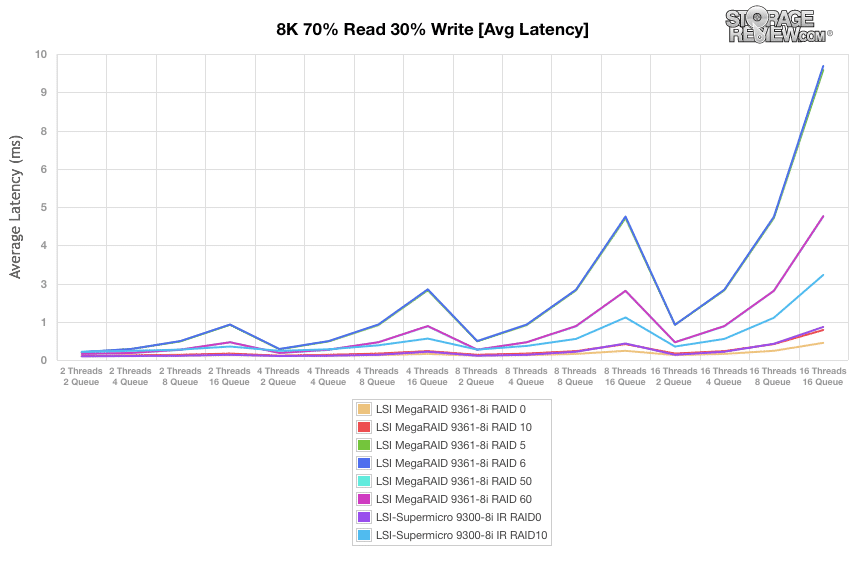
Most of the RAID configurations performed fairly well in the average latency tests, especially MegaRAID RAID 0, which had almost no latency spikes. The MegaRAID in RAID 6 configuration, however, was the exception with a maximum average latency reaching almost 10ms. One item that tracked off the chart was the max latency for the LSI 9300-8i IR in RAID10, which fluttered above 1,000ms.
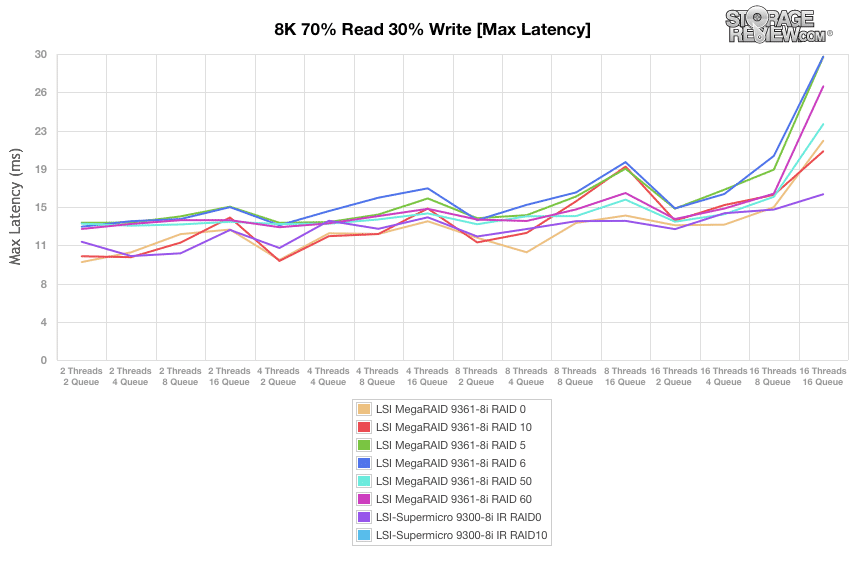
Among the RAID configurations, the MegaRAID RAID50 and LSI 9300-8i IR RAID0 offered the narrowest standard deviation by16T/16Q level. Again, LSI’s MegaRAID RAID 5 and 6 configuration spiked quite a bit during these tests and had significantly higher standard deviation by the end. The 9300-8i IR in RAID10 again plotted off this chart in the 11-37ms standard deviation range.
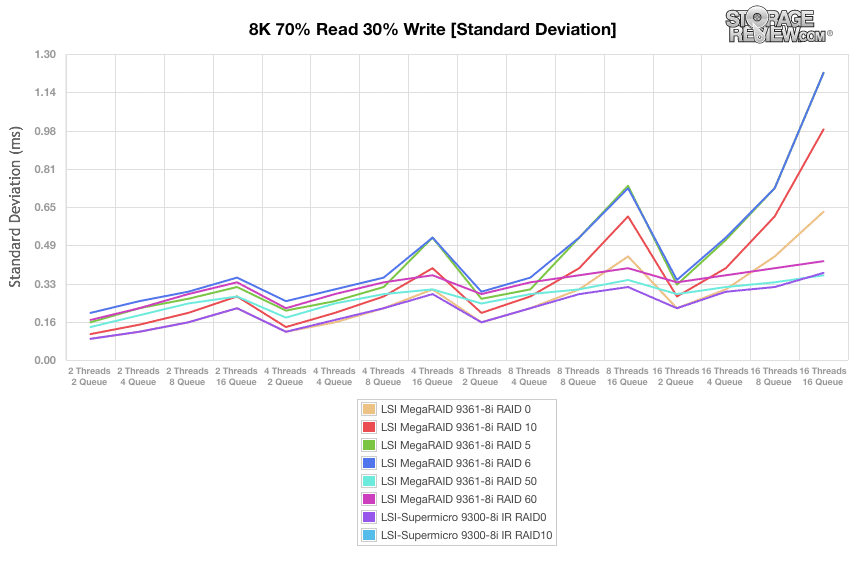
In our next benchmark, we are still sticking with the 8k transfer size, but changing to sequential 100% read and 100% write operations. Under this workload, the MegaRAID in RAID 0 configuration continued to shine, reaching 482,722 IOPS and 438,929 IOPS for read and write respectively. We also see the benefit of moving to a hardware RAID solution over the HBA with integrated RAID capabilities, where for a given RAID configuration the H/W solution had double the read performance.
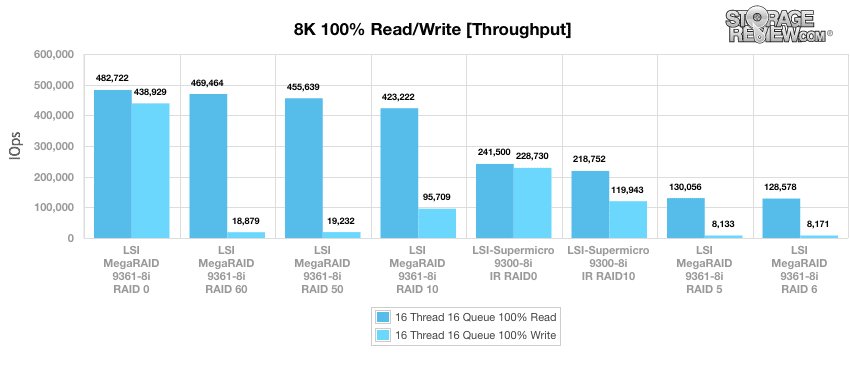
In our final synthetic benchmark, we utilized a much larger 128k transfer size with 100% read and 100% write operations. Under this workload, most of the RAID configurations for both MegaRAID and Supermicro were neck-in-neck for Read throughput; however, the MegaRAID RAID 0 once again came out on top in the the write column by a significant margin.
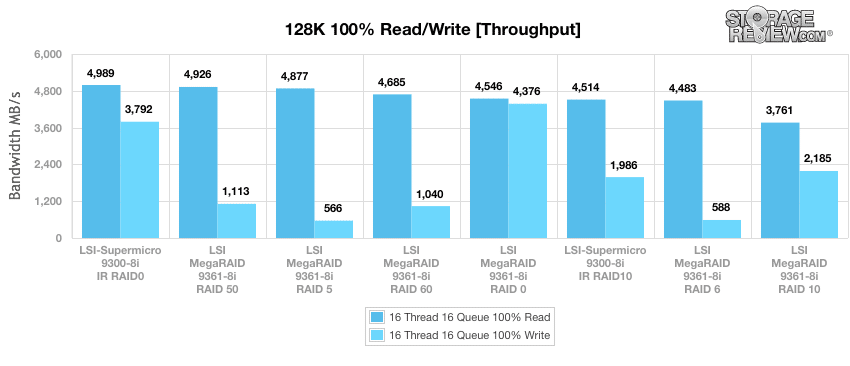
Conclusion
The LSI MegaRAID SAS 9361-8i brings a complete SAS3 RAID solution to market for servers that want the most out of their high-end storage, but require the reliability, compatibility and data protection that is the heritage of LSI. With expanders, the 9361-8i can support up to 128 SATA or SAS drives. While the card is designed for SAS3 drives, it is of course backward compatible. LSI supports RAID levels 0,1,5,6,10, 50, and 60 with the 9361-8i, and enterprise data protection though CacheVault (optional) which adds another layer of protection should a drive look as if it has failed.
Turning to performance the LSI 9361-8i is no slouch when it comes to handling the latest and greatest SAS3 SSDs. Managing eight Hitachi SSD800MM SSDs we tested all the RAID modes supported on the card and compared them to the integrated-RAID featureset on a LSI/Supermicro 9300-8i. In RAID0, we measured over 556k IOPS read 573k IOPS write in our 4k random test and just shy of 450k IOPs in our mixed workload 8k 70/30 test. This translates to roughly double the performance in comparison to the HBA model which supports both RAID0 and RAID10. To be fair the HBA is obviously not intended for the highest performance configurations, but the comparative scale is relevant.
Switching to sequential workloads, we saw throughput top out in our 8k test at 482k IOPS read and 438k IOPS write in RAID0. In large-block transfers the 9361-8i tipped the scales at offering just shy of 4.9GB/s read in its RAID50 mode and RAID0 offering the highest write bandwidth at 4.3GB/s sustained. Overall when it comes down to supporting the latest generation of SSDs, the LSI MegaRAID 9361-8i has a lot to offer. It builds on the incredibly popular SAS2 models before it, while adding support for SAS3 SSDs that can reach speeds individually of up to 1GB/s R/W.
Pros
- Excellent performance to pair with SAS3 SSDs
- Offers CacheVault flash cache protection
- Wide driver support
Cons
- Limited to 8 internal ports on the card
The Bottom Line
The LSI MegaRAID SAS 9361-8i storage adapter lets the latest generation SAS3 SSDs focus on saturating the PCIe Gen3 bus without having to worry about the RAID card holding them back.
LSI MegaRAID 9361 at Amazon



 Amazon
Amazon